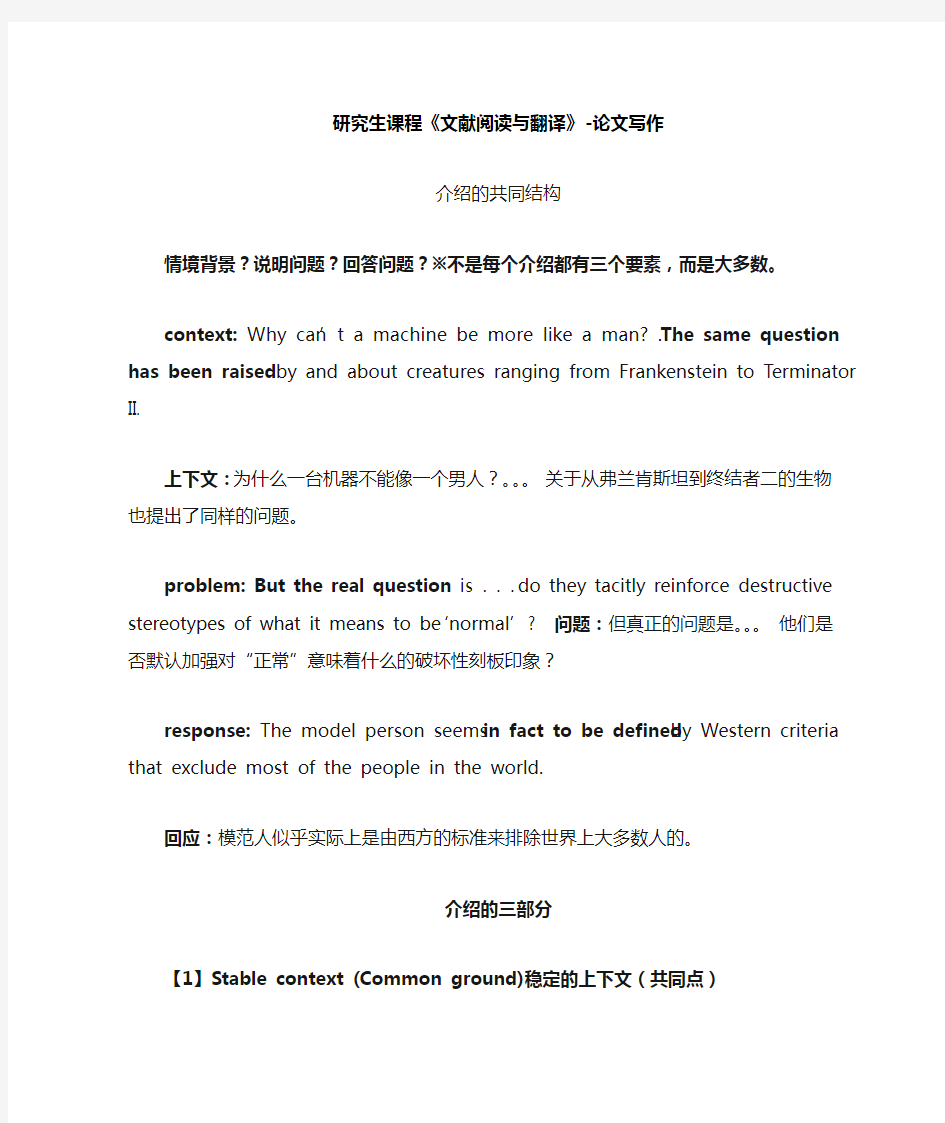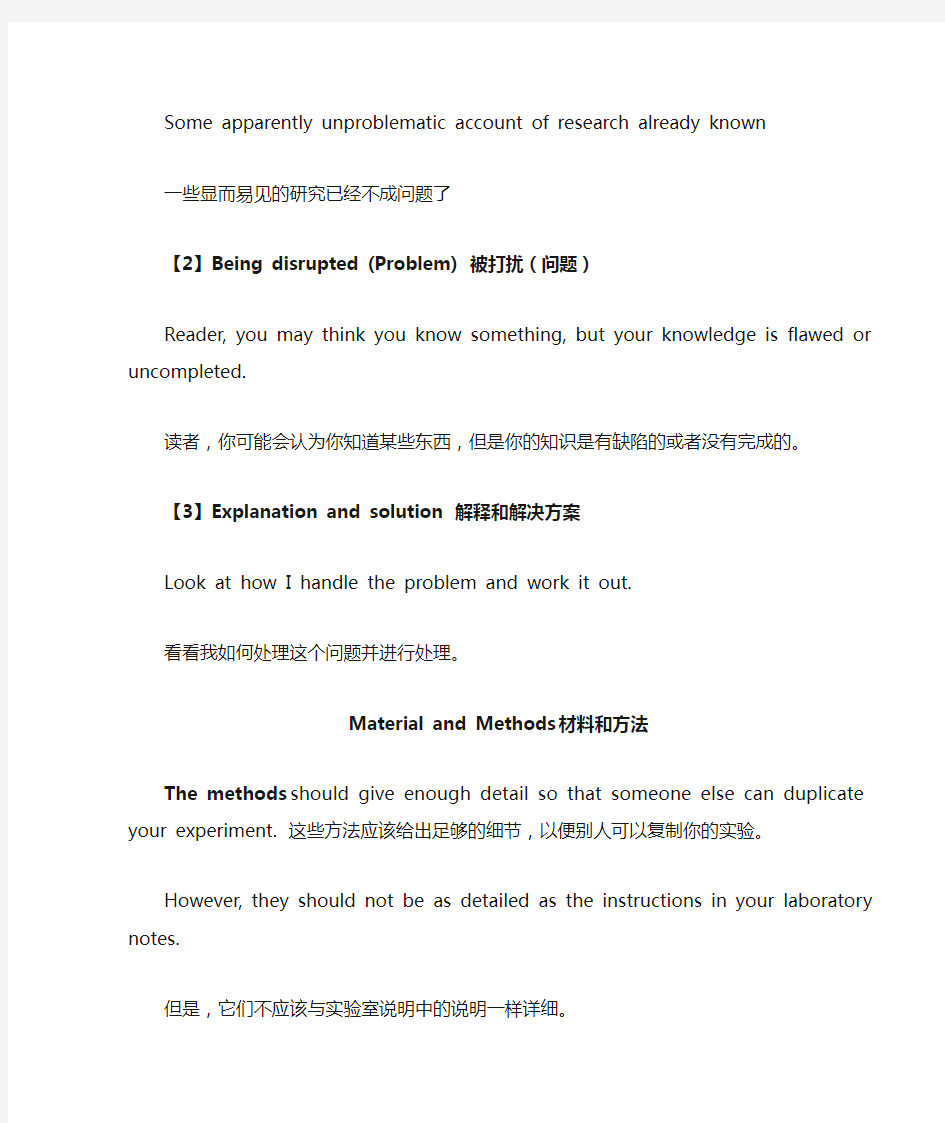研究生课程文献阅读与翻译论文写作


研究生课程《文献阅读与翻译》-论文写作
介绍的共同结构
情境背景?说明问题?回答问题?※不是每个介绍都有三个要素,而是大多数。context: Why can’t a machine be more like a man? . . . The same question has been raised by and about creatures ranging from Frankenstein to Terminator II.
上下文:为什么一台机器不能像一个男人?。。。关于从弗兰肯斯坦到终结者二的生物也提出了同样的问题。
problem: But the real question is . . . do they tacitly reinforce destructive stereotypes of what it means to be ‘normal’? 问题:但真正的问题是。。。他们是否默认加强对“正常”意味着什么的破坏性刻板印象?
response:The model person seems in fact to be defined by Western criteria that exclude most of the people in the world.
回应:模范人似乎实际上是由西方的标准来排除世界上大多数人的。
介绍的三部分
【1】Stable context (Common ground) 稳定的上下文(共同点)
Some apparently unproblematic account of research already known
一些显而易见的研究已经不成问题了
【2】Being disrupted (Problem) 被打扰(问题)
Reader, you may think you know something, but your knowledge is flawed or uncompleted.
读者,你可能会认为你知道某些东西,但是你的知识是有缺陷的或者没有完成的。【3】Explanation and solution 解释和解决方案
Look at how I handle the problem and work it out.
看看我如何处理这个问题并进行处理。
Material and Methods 材料和方法
The methods should give enough detail so that someone else can duplicate your experiment. 这些方法应该给出足够的细节,以便别人可以复制你的实验。However, they should not be as detailed as the instructions in your laboratory notes. 但是,它们不应该与实验室说明中的说明一样详细。
Remember not to comment on your observations or measurements in the methods stage. You should do this in the results stage.
记住不要在方法阶段评论你的观察或测量。你应该在结果阶段做到这一点。The information you provide should typically answer the following questions:
What materials did you use? What methods did you use?
您提供的信息通常应该回答以下问题:你使用什么材料?你用什么方法?
How should I begin the Methods? 我应该如何开始“方法”?(a) making a general statement about your method (a)就您的方法作一般性的陈述The method described here is simple, rapid and sensitive. 这里描述的方法简单快速(b) referring to another paper (b)提及另一份文件
The materials used for isolation and culture are described elsewhere [20].
Materials were obtained in accordance with Burgess et al.’s method [55].
(c) stating where you obtained your materials from (c)说明您从哪里获取材料Bacterial strains were isolated and kindly supplied by…
Agorose for gel electrophoresis was purchased from Brogdon plc (Altrincham, UK).
(d) explaining how you found your subjects (d)解释你如何找到你的实验对象Subjects were chosen from a randomly selected sample of…
Participants were selected from patients at the Gynecology Faculty of the University (e) indicating where (i.e. a geographical location) your investigation was focused (e)指出您的调查重点在何处(即地理位置)
Our empirical investigation focused on Tuscany, a central region of Italy.
The study was carried out in four boulevards in Athens (Greece).
(f) referring the reader to a figure which shows the experimental set up
(f)将读者引用到显示实验设置的图中
To highlight the advantages of the system, Fig. 1 shows the…
(g) starting directly with the first step in your procedure
(g)直接从您的程序中的第一步开始
Frontal cerebral cortices were dissected from…
Core-cell composite materials were prepared by colloidal assembly of…
Results 结果
Resist the urge to include every bit of data you collected, since perhaps not all are relevant. Also, don’t try to draw conclusions about the results—save them for the Discussion section. 抵制你收集的每一点数据的冲动,因为也许并不是全部都是相关的。此外,不要试图得出关于结果的结论- 将其保存在讨论部分。
Most Results sections feature three distinct parts: text, tables, and figures.
大多数结果部分有三个不同的部分:文本,表格和图形。
How to begin the Results? 如何开始结果?
【1】Give a general panorama of your experiments, surveys.
【1】给你一个全面的实验,调查。
Overall, the results presented below show that…总体来说,下面的结果显示:The three key results of this empirical study are: .. 这个实证研究的三个主要结果:【2】Go directly to your results, often by inviting readers to look at figures or tables. 【2】直接转到你的结果,经常是邀请读者看图或表。
Figure 1 shows the mass spectra obtained from an analysis of the two residues. The first residue reveals…
图1显示了从两个残基的分析获得的质谱。第一个残留物揭示了...
A total of 34 wheat genotypes(Table 1) were screened for…Responses to increased sunlight varied significantly (Figure 1)…
共筛选了34种小麦基因型(表1)...对阳光照射的反应明显不同(图1)...
An analysis was made to look for …To do this, the average times of x and y were compared…Figures 1-3 s how the difference between…
.进行分析以寻找...为此,比较x和y的平均次数...图1-3显示了...之间的差异
Discussion and Conclusion 讨论和结论
1. Statement of principal findings 1.主要发现声明
2. Strengths and weaknesses of the study 2.研究的优缺点
3. Strengths and weaknesses in relation to other studies: important differences in
results 3.与其他研究相关的优点和缺点:结果的差异
4. Meaning of the study: possible explanations and implications for others in your field and policymakers
4.研究的意义:对您领域的其他人以及决策者的可能解释和影响
5. Unanswered questions and future research
5.未回答的问题和未来的研究
Possible beginnings of Discussion 可能的讨论开始
(1)Remind readers of the writer’s goals, preferably in a single sentence:
(1)提醒读者作者的目标,最好是一句话:?
One of the main goals of this experiment was to find a way to predict who shows more task persistence.
这个实验的主要目标之一是找出一种方法来预测谁能显示更多的任务持久性。
(2)Refer back to the questions (hypotheses, predictions etc.) in the Introduction: (2)参考引言中的问题(假设,预测等)?
These results both negate and support some of the hypotheses.It was predicted that greater perfectionism scores would result in greater task persistence, but this turned out not to be the case. 这些结果都否定和支持一些假设。据预测,更大的完美主义分数将导致更大的任务持续性,但事实证明不是这样。
(3) Refer back to papers cited in Literature Review :
Previous studies conflict with the data presented in the Results:it was more common for any type of feedback to impact participants than no feedback (Shanab et al., 1981; Elawar & Corno, 1985).
以前的研究与结果中提供的数据相冲突:任何类型的反馈对参与者的影响比没有反馈更为常见(Shanab等,1981; Elawar&Corno,1985)。
(4)Briefly restate the most important points from Results:
(4)从结果中简要重述最重要的一点:
While not all of the results were significant, the overall direction of results showed trends that could be helpful to learning about who is more likely to persist and what could influence persistence.
虽然并不是所有的结果都是重要的,结果的整体方向显示出趋势,可能有助于了解谁更有可能持续,什么可能影响持久性。
